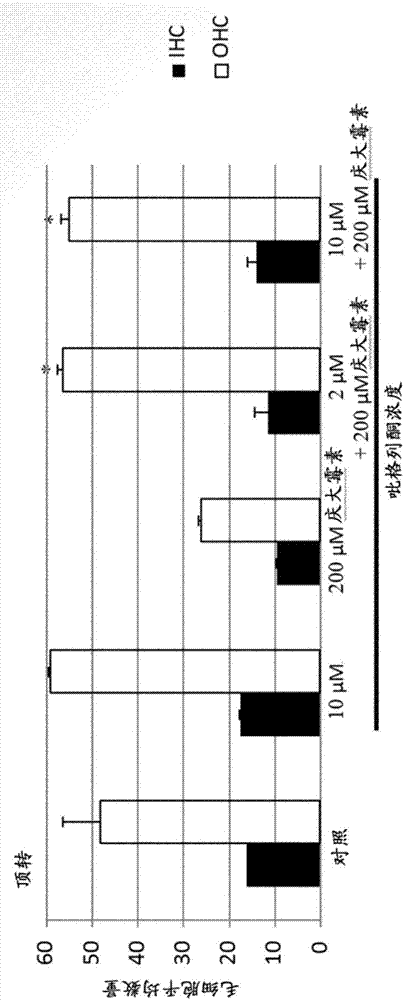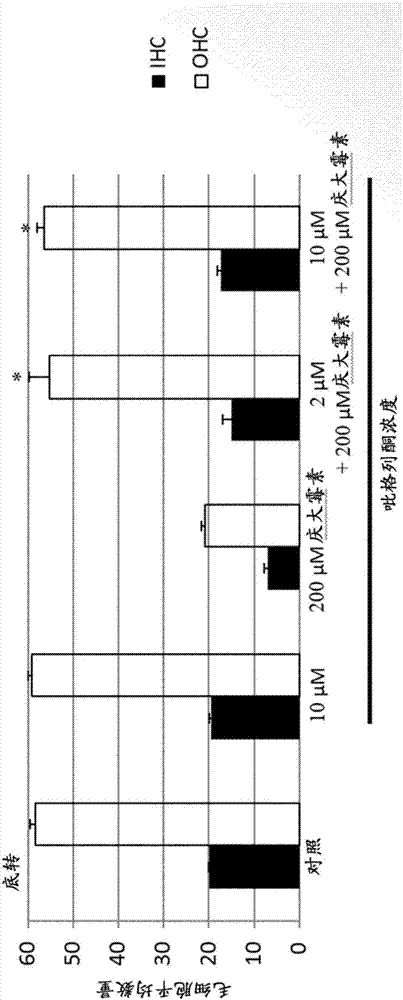Method of preventing or treating hearing loss
A technology for hearing loss and noise damage, which can be used in pharmaceutical formulations, medical preparations containing active ingredients, drug delivery, etc., and can solve problems such as high medical needs
- Summary
- Abstract
- Description
- Claims
- Application Information
AI Technical Summary
Problems solved by technology
Method used
Image
Examples
Embodiment 1
[0115] Example 1: Prevention of antibiotic-induced hair cell damage
[0116] The organ of Corti was obtained from postnatal day 5 Sprague-Dawley rats and placed in organ culture. After 48 hours of culture, gentamicin treatment resulted in a 50-70% loss of hair cells. Combination pioglitazone treatment was protective, almost completely preventing gentamicin-dependent hair cell loss and largely preserving organ morphology.
[0117] method
[0118] animal handling
[0119] All animal surgeries were performed according to the Kantonales in Basel, Switzerland. Approved program proceeds. Postnatal day 5 (p5) Sprague-Dawley rats were used for the study. Studies were performed in vitro using organ of Corti (OC) explants from p5 animals. Animals were sacrificed and the cochlea was carefully dissected to separate the organ of Corti from the spiral ganglion, vascular striatum, and Reissner's membrane [Sobkowicz HM, Loftus JM, Slapnick SM. Acta Otolaryngol Suppl. 1993;502:3-36] . ...
Embodiment 2
[0126] Example 2: Preventing Noise-Induced Hearing Loss
[0127] Formulations of pioglitazone or vehicle alone were administered to the middle ear of guinea pigs. Animals were then exposed to noise impairment (broadband noise 4-20 kHz, 115 dB (SPL)) and auditory sensitivity recordings over a standard frequency range were performed 7-14 days later. The results obtained in the hearing tests were compared with the pre-injury baseline values. Pioglitazone preserved hearing, resulting in a >50% reduction in threshold shift in pioglitazone-treated animals relative to vehicle controls.
[0128] method
[0129] animal handling
[0130] The guinea pig model is the preferred animal species for hearing research. Drug application as well as noise injury was applied under general anesthesia. Upon arrival, animals underwent an acclimatization period of at least one week prior to experimentation. Animals were housed in pairs in a temperature- and humidity-controlled environment with a ...
Embodiment 3
[0139] Example 3: Prevention of antibiotic-induced hair cell damage by dual PPARα / γ agonists and PPARα selective agonists
[0140] This experiment was performed similarly to that in Example 1. Gentamicin treatment, after 24 hours of exposure to cultured mouse OC, resulted in a 50% loss of hair cells. Treatment with the dual PPARα / γ agonists moglitaza and teglitaza and with the PPARα selective agonist fenofibric acid prevents gentamicin-dependent hair cell loss.
[0141] method
[0142] The method is similar to that of Example 1. The main difference is the use of mouse OC instead of rat OC. In addition, treatment with 50 μM gentamicin was performed for 24 hours. The number of OCs used for each experimental condition was 3–5. The concentrations of the test substances Tigreza and Moglitaza were 2 μM and 10 μM, and fenofibric acid was 25 μM and 150 μM.
[0143] result
[0144] The untreated organ of Corti was well preserved after 24 hours of culture, and there were complete...
PUM
 Login to View More
Login to View More Abstract
Description
Claims
Application Information
 Login to View More
Login to View More - Generate Ideas
- Intellectual Property
- Life Sciences
- Materials
- Tech Scout
- Unparalleled Data Quality
- Higher Quality Content
- 60% Fewer Hallucinations
Browse by: Latest US Patents, China's latest patents, Technical Efficacy Thesaurus, Application Domain, Technology Topic, Popular Technical Reports.
© 2025 PatSnap. All rights reserved.Legal|Privacy policy|Modern Slavery Act Transparency Statement|Sitemap|About US| Contact US: help@patsnap.com



